Neural Correlates of Emotional and Social Relevance in EEG and fMRI

The combined processing of sensory, emotional and social information is an essential part of our every day living and to investigate how the brain reacts to this input was the scope of two different MRI studies.
The first study combined EEG, exploring the temporal processing of emotional and social stimuli, with fMRI to localize the associated brain regions. Analysis showed that social and negative content (being evolutionary more important) evoked larger activation than non-social and positive content. But in contrary, especially in the early processing stage, the combination of a social and positive content is advantageous and able to modulate the following response to negative stimuli, i.e. the fast realization that you have a friend at the side is important for the judgement of a negative emotional situation.
The second study, combining fMRI with behavioural measures, investigated the sensory and emotional aspects of slowly being stroked with different materials at the hand and at the lower arm. During the fMRI measurements participants judged the stimuli as either “pleasant” or “neutral”. That reveals that the location of the stroking does matter: materials resulted more often in a pleasant feeling when applied at the arm, which was especially true for materials felt “neutral” at the hand. This effect can be explained by receptors being optimized for sensory perception in the hand and receptors being able to evoke positive emotions - even with neutral materials - being present at the arm.
Project leaders

Susann Boretius +49 551 3851-390 +49 551 3851-394 Contact

